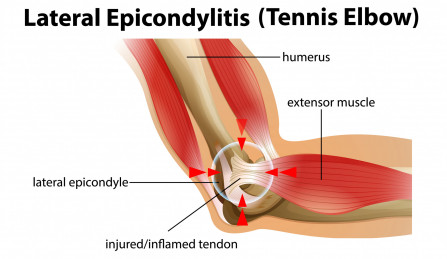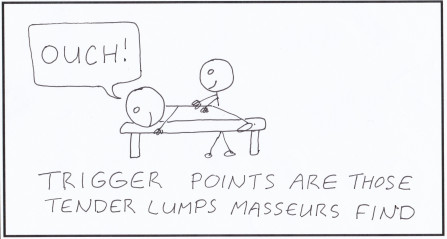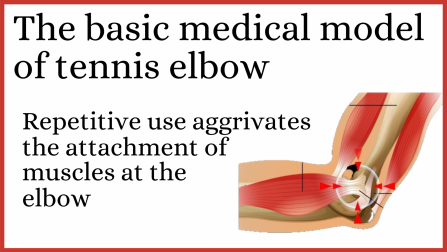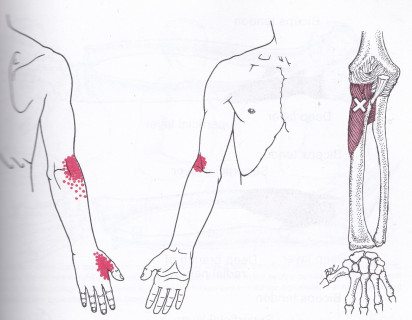Are massage guns a gimmick?
A gimmick is something that is not of real value used to attract attention, usually to get you to buy something. Massager guns certainly... Read Article

(Myofascial) trigger points are a large but often overlooked cause of tennis elbow, with this omission being responsible for too many tennis elbows not healing and too many people suffering un-necessarily. In this article we will go over how trigger points cause tennis elbow and the evidence that medics too often ignore. We will then show you how to check your own tennis elbow for this problem, then give practical advice on how to fix it.
The way we'll do this is to:
Tennis elbow is the irritation or injury to the outside of the elbow where many of your forearm muscles are attached. This attachment is called the lateral epicondyle, so has the technical name of lateral epicondylitis. The condition is common in tennis players, hence the name tennis elbow, but it can be caused by any repetitive activity involving forearms and gripping. It is even a common problem in those continually using a computer.

Simply speaking, trigger points are those tight lumps in your muscles that therapists find. We cover these a lot more in our article Trigger point basics.
The important thing is they start as small lumps then slowly develop over time, and can eventually start referring pain, but even before then they cause the muscle they are in to abnormally tighten (1,2). As we will see the referred pain can mimic tennis elbow, plus the tightening of the muscle causes extra stress where it attaches to the elbow.
We will start by showing you the simple model of how tennis elbow forms that you’ll find in medical journals and most articles or videos. This ignores the effects of trigger points. We'll then show you how trigger points contribute and discuss the problems ignoring them cause.

The simple explanation of tennis elbow is that repetitive activities create stress on the attachment of the muscles at the lateral epicondyle (outside of your elbow) causing irritation, leading to inflammation and injury. The explanation continues saying that tendons are slow to heal, and there can be a buildup of scar tissue that causes further irritation, causing the condition to become entrenched (3–5).
As well as creating stress upon the attachment at the lateral epicondyle the repetitive activities cause muscles to tighten and develop trigger points. As discussed below these:
As discussed, trigger points can cause tennis elbow by causing abnormal tension in the forearm muscles that attach to the lateral epicondyle at the outside of the elbow.

As shown in this diagram trigger points from some muscles can refer pain to the elbow region, so they can mimic or add to the pain of a tennis elbow injury.
The evidence that trigger points are a big cause of tennis elbow
There is a large amount of scientific evidence showing that trigger points are heavily involved in tennis elbow. Despite this Medical journals typically ignore them, and standard treatments typically just include rest, ice, non-steroidal anti-inflammatory drugs, corticosteroid injections, exercises and stretching (4,5). Why are trigger points ignored? You can't treat trigger points with drugs and selling pain killers and inappropriate tennis elbow treatments is big business.
The evidence
- Scientists have established that activity causes trigger points and that they cause muscles to tighten (1,2,6–8). Tightness obviously causes stress where the muscles attach.
- Further, several studies have shown that tennis elbow sufferers have large numbers of trigger points compared with non-sufferers (9–11), and
- trigger point therapy is shown to provide effective relief (3,12–14).
It's very simple. Doctors tell you to rest and take pain killing drugs expecting this to relieve the stress and the elbow to heal, but instead the abnormal tension and referred pain remains. They'll start blaming the elbow for not healing, then start rubbing it, sticking in needles or zapping it with laser, but of course that's useless because the abnormal rension still won't let it heal. Eventually they get to sell you a life time of drugs, needles, useless therapies and maybe even a surgery. Everyone benefits- except the patient.
Lets look at how tennis elbow is diagnosed. The tests are something simple you can do yourself, but please discuss them with a professional.
The symptoms of tennis elbow are pain at the outside of your elbow, aggravated by activities such as bending back your wrist or fingers, or by gripping.
There are two basic tests a doctor will do to diagnose tennis elbow.
Examine the outside of your elbow. It will be very tender at the bony bump (lateral epicondyle) and for 1-2 cm towards your wrist (the tendon).
There are a couple of tests with the impressive sounding names Mills and Cozens tests, but these are basically i) bending your wrist forward to tighten the muscles at the back of your forearm that attach to the lateral epicondyle, and ii) bending the wrist back the other way against resistance. These pull on the area injured in tennis elbow, so if they cause pain it is considered positive.
If you have tennis elbow we have two simple tests for trigger point involvement. The first is to simply check for trigger points to see if you have them. The second is to see if treating the trigger points relieves your tennis elbow. here are the details.
To do this you simply examine your forearm muscles for trigger points. This can be done using the technique demonstrated in our video on forearm muscles.
This simply tests what happens if the tension caused by trigger points is temporarily removed.
This is to simply do the basic tests for tennis elbow already described. Try gripping something or bending your wrist back against resistance to reproduce the pain, then examine the outside of your elbow for tenderness.
Temporarily relieve the tension in your forearm muscles by treating the trigger points using either of the two methods in our video
Repeat the same tests that you did in step one. If your elbow is less tender or the tests cause less pain this means that the trigger points are a problem, and now what you need to do is get rid of them.
If you have tennis elbow we have a very comprehensive article How to treat your tennis elbow at home
If through sport or work you use your forearm muscles a lot it is important to understand that tennis elbows and the associated abnormal tension build up slowly, then it takes further time with this abnormal stress for the elbow to become inflamed and start feeling sore. Because of this we thoroughly recommend that as a preventative measure you regularly do the forearm muscle massages shown in our video
We are continually adding more information on research and uses. Subscribe below to have us email them to you "hot off the press".

Several years ago Dr Graeme, a Chiropractor practicing in Victoria, Australia was looking for a serious hand held massager his patients could use at home to get the extra quality massage they needed. The ones he found in the shops and on-line for home use looked nice but were not serious, and... read more
A gimmick is something that is not of real value used to attract attention, usually to get you to buy something. Massager guns certainly... Read Article
Clinical trials have shown that massage is effective in relieving fibromyalgia. However, the results show that some are better than... Read Article
Tennis elbow is a painful condition where prolonged abnormal tension in your forearm muscles causes the site where they are attached to... Read Article
Do not refresh or leave this page until loading complete.